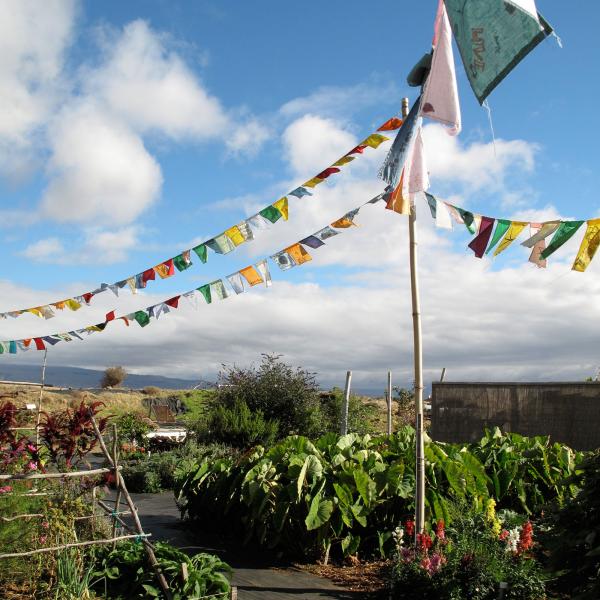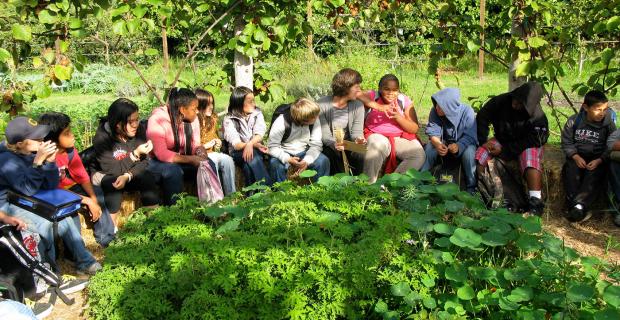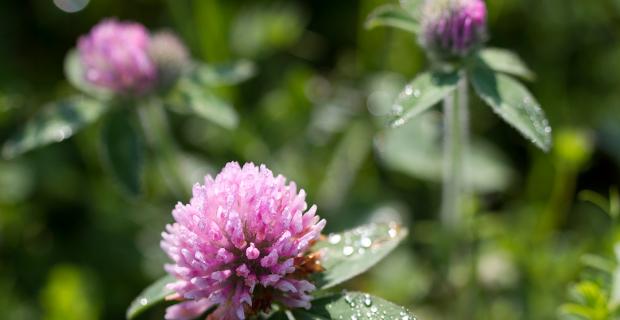Supporting the Growing School Garden Movement in Hawai'i

Think "Hawai'i," and lush, abundant landscapes likely come to mind. Yet statistics tell a different story:
- Located more than 2,000 miles from the nearest port, Hawai'i imports 85–90% of its food and has less than a seven-day supply in stores at any given time, making it vulnerable to economic disruptions and natural disasters.
- Over 9% of residents are "food insecure," which means they lack consistent access to enough food for a healthy, productive life.
- There is heightened demand to feed the state's 1.3 million residents and 7 million-plus annual tourists.
- Like the rest of the country, Hawai'i is faced with rising rates of diabetes (up 15% from 2005 to 2009) and childhood obesity (28.5% of youth ages 10–17 are overweight or obese, and a 2003 study found that 30–40% of kindergarteners in rural communities were already overweight or obese).
Fortunately, statewide efforts to promote food self-sufficiency and sustainability are taking root, including the creation of a Hawai'i Environmental Literacy Plan (HELP) to educate the next generation. Of particular note is a flourishing K–12 school garden movement, as more Hawai'i educators recognize the value of gardens as vibrant living laboratories that enhance student health, academic achievement, ecological understanding, and local agriculture.
To support this movement, the Center for Ecoliteracy partnered with the research and education institute Kohala Center in 2010 to host "Smart by Nature: Growing School Garden Curriculum K–12." This three-day conference in Waimea attracted over 80 classroom and garden teachers from five Hawaiian islands — all of whom left with a rich library of resources, including a collection of Center for Ecoliteracy essays and books (Smart by Nature, Big Ideas, Ecological Literacy, and the how-to garden guide Getting Started). The gathering featured success stories and lessons learned, site visits, homegrown meals, and songs and rituals honoring the islands' indigenous inhabitants.
It also responded to a long-simmering desire to form a new statewide coalition of school gardens. "[Center for Ecoliteracy executive director] Zenobia Barlow helped us to articulate our goal for 'A Garden in Every School, A Garden Teacher in Every Garden, and A Fully Integrated Curriculum,'" recalls Nancy Redfeather, program director of the Hawai'i Island School Garden Network. "That was the moment everything gelled." Four months later, the Hawai'i Farm to School & School Garden Hui met for the first time, representing the combined forces of school garden networks from the islands of Hawai'i, Kaua'i, O'ahu, Moloka'i, and Maui.
The Center for Ecoliteracy continues to inspire educators on the islands through its widely shared publications. In Maui, for example, Big Ideas and Smart by Nature have become popular reads among school principals and teachers, reports Lehn Huff, coordinator of the Maui School Garden Network. She singles out the Center's middle-school curriculum guide to the PBS special Nourish: Food + Community, noting that teachers and students alike enjoy fun, thought-provoking activities like analyzing messages in food ads and crafting seasonal local food wheels. Huff now offers free presentations to teachers on how to use the Nourish curriculum at all Maui public middle schools and several independent middle schools.
Despite budget constraints, more garden teacher positions are emerging throughout Hawai'i. Last month, the Kohala Center was awarded a USDA grant to create a statewide professional development curriculum and certified training program for K–8 school garden teachers. Set to launch at the 2012 Summer School Garden Conference, it will engage teachers in study of the agricultural sciences, STEM (Science, Technology, Engineering, and Math) integration, garden curriculum correlated with state standards, and nutrition education from seed to table, among other subject areas.
"Within the garden teacher ranks, there are very few who are trained teachers as far as curriculum goes. We want to address that issue with this program," says Redfeather, who stresses the importance of place- and project-based learning. "In Hawaiian, there's a saying, 'Ma ka hana ka ike' — 'By using our hands, we learn,' or 'By doing, we learn.' Hands-on, experiential learning is the traditional way here, much more than 'book' learning. Our children have been literally sitting at their desks for 10 years because of No Child Left Behind. They're so disconnected from food and environment, from knowing how to take care of land, families, communities, and themselves. We want to get them back outside."
The training course will also incorporate many Center for Ecoliteracy resources, including its new cookbook and professional development guide, Cooking with California Food in K-12 Schools, and the Food, Inc. discussion guide.
"Most school garden curriculum is very cookie-cutter and hard to adapt to a unique place like Hawai'i," notes Redfeather. "We're a melting pot of many, many cultures with their own strong food traditions and ways of looking at the Earth. But the Center for Ecoliteracy has developed the most innovative, widely adaptable resources for teachers, and their ideas form the basis of pedagogy and curriculum that all garden teachers need to keep in the forefront of their minds. These materials can be woven into school garden programs from Hawai'i to Maine."




